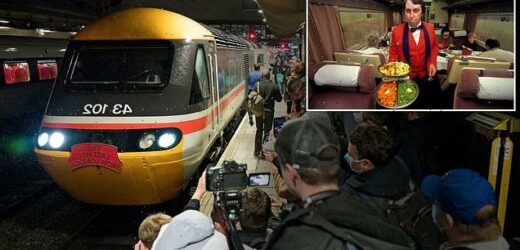The train on platform 1 is leaving… for good! After 45 years as rail workhorse, poignant scenes as InterCity 125 is put out to grass
- The InterCity 125 said farewell as it took its final journey on the main network
- Record-breaking locomotive 43 102 was chosen for last journey before retiring
- It will be displayed at the National Railway Museum in Shildon, County Durham
- InterCity 125s were developed in early 1970s before coming into service in 1976
- They have been replaced by Hitachi locomotives, which are now being inspected
Speeding millions of holidaymakers, workers and students around the country, they have been part of British life since 1976.
But after sterling service as the workhorse of the railways, the InterCity 125 has taken its final journey on the main network.
The historic farewell came at London St Pancras on Saturday – with a record-breaking locomotive taking the spotlight.
Trainspotters thronged the platform to admire the 43 102, painted in the swallow livery in which it broke the record for a diesel: 148.5mph in 1987.
The InterCity 125 has taken its final journey on the main network and the historic farewell for the locomotive (pictured at Leeds railway station) came at London St Pancras on Saturday
It carried a commemorative plate declaring: ‘The last HST from London – 1976-2021.’
After covering tens of millions of miles since 1978 it will be retired and displayed at the National Railway Museum site in Shildon, County Durham.
InterCity 125s, also known as High Speed Trains or HSTs, were developed in the early 1970s before coming into regular service in 1976.
Under the slogan ‘Let the train take the strain’, they provided almost all services from London to the West Country and South Wales, and many trains on the East Coast Mainline between London, Yorkshire and Scotland.
East Midlands Railway, running from London to the East Midlands and South Yorkshire, was the last route to and from the capital to have the trains in regular service.
They have been replaced by Hitachi locomotives, currently being inspected after cracks were found.
InterCity 125s (pictured in 1985), also known as High Speed Trains or HSTs, were developed in the early 1970s before coming into regular service in 1976
Paul Williams, co-driver of 43 102 on its last journey to Leeds, said: ‘It is seen as the train that saved the railways. The railways were in decline because of the motorways. People were leaving the railways because the trains were old and decrepit.
‘British Rail wanted this new face of the train and came up with the HST. It did its job. It was only seen as a ten-year stop gap until the railways were electrified.’
Anthony Coulls, of the National Railway Museum, said: ‘The power car 43102 is really assured of its place in history.
‘It’s the fastest diesel train in the world and growing up, every kid wanted a 125 on their Hornby train set. I never got one, but now we’re getting the full-size version.’
He added: ‘The fact that 40 years on, they are just leaving service, demonstrates just how successful these trains were.’
A small number of 125s have been modernised and remain in use on local services in the West Country, in Scotland and on the Cross Country route from Scotland and the North East to south-west England.
Source: Read Full Article




